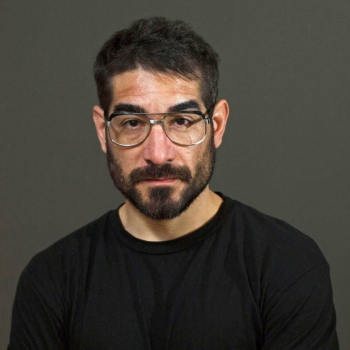Internationally recognised, Solimán López is a conceptual artist. A new media researcher, specialised in science, biotechnology, web 3.0, and interactive and digital art. Solimán, whose work has been exhibited in festivals, museums, art centres and galleries in more than 20 countries, likes to arouse the public’s curiosity, provoke introspection, and initiate conversations that extend outward.
His passion for fusing art and technology has fuelled the Gaze Machine, a project created for Eyes of the world, where the artist’s brushstrokes are lines of code, and the canvas is a digital matrix.
The Gaze Machine is an interactive digital art device: a camera that captures gazes, which in turn become catalysts for transformation. For every gaze, sponsored by Alcon, one person in Mozambique receives cataract surgery as part of the Eyes of the world project.
Glances at the Gaze Machine become art, and art becomes the gift of vision. What could be more magical?
How did you get in touch with Eyes of the world? What attracted you most to our organisation?
It is said that we are no further from each other than six people away. I think this was a clear example, as Núria Ramon and I shared the connection with Betty Bigas, who decided to connect us with the confidence that something interesting could emerge.
When I began to investigate the reality of the Foundation and its social leitmotiv, I automatically understood that I had to participate and contribute to the project. In my work, the organ of vision is very important and I believe that maintaining it is a right that all living beings on this planet should have. Respecting the gift of seeing the world around us, seeing others and appreciating art (when it has important visual components) is an obligation.
What is the Gaze Machine and how does it work?
Gaze Machine is a conceptual digital artwork that becomes a collective experience. Each stroke, movement, and blink of the eyes becomes an input of digital information that feeds the artwork, generating a memory of gazes inside the Gaze Machine.
This symbolic and metaphorical action of creatively using the gaze is related to the social work that the Eyes of the world Foundation carries out in Mozambique. Each participant’s gaze is transformed into a cataract surgery. After recognising the gaze, the system stores the data of these movements and reproduces them in subsequent exhibitions, as if it were a collective gaze log.
The project is based on an algorithm using an artificial intelligence library, which is able to recognise the position of the participants’ pupils. This information, collected in X-Y coordinates, modifies the presence and outline of a 3D model that develops and grows in the interface, creating a unique sculpture for each participant. This sculpture is then linked to the information captured before and after. The work is also prepared to be able to analyse images in real time and feed the system with this information obtained from looking at images of our surroundings, such as cities, other humans, or elements of nature.
Why did you decide to launch this project?
After several months of conversations with Eyes of the world, we managed to find a project that would contribute to the world of digital art and, of course, help the Foundation in its social work. For me, this was the main motivation, but the challenge was to make the viewers participants and protagonists so that, in some way, they would be integrated into the action and the initiative.
The gaze has been used to a large extent throughout the history of art, but from a passive point of view, with the exception of photography and video, in which the photographer’s or videographer’s gaze is part of the action of creating the image in connection with the device. The use of the gaze as a device for interaction with a digital interface has less precedent, but I think it is conceptually an interesting point to address. Can our organ of vision be an artistic tool?
These are some of the conceptual motivations, but I would like to qualify that the main impulse of the Gaze Machine is to develop a socially positive project through the connection between art, science, and technology.
What inspired you and what do you hope to achieve with this initiative?
We hope to achieve a significant level of participation and, above all, to raise awareness among our target audience. I hope that the project will generate a butterfly effect, expanding this initial action to other parts of the world, and thus continuing to support the Foundation and its important mission.
Artistically the work is not closed, and we are creating updates and new versions that will help us (my studio and the Foundation) to participate in other environments in the world of art and technology, thus bringing the project and its message to a wider audience.
What would you like the Gaze Machine to do next, and how do you think you could continue to support the Foundation in the future?
I hope that in the end the Gaze Machine will appeal to its own title and become an artistic and social tool for the Eyes of the world Foundation to achieve its charitable and medical objectives. In this sense, it was already something that was worked on from the beginning of the coding of the work together with the technical artist Daniel Sabio Mandry.
We needed a project that could be adapted to different contexts and environments, because in this case, we didn’t want to show off grandiloquent staging, but rather to be able to fit into the reality of a work and production that seeks to support solidarity.
My support for the future is to continue to be there, present, alongside the Gaze Machine, to continue to make the project grow and increase its international visibility. That was my initial commitment, and I stand by it.
